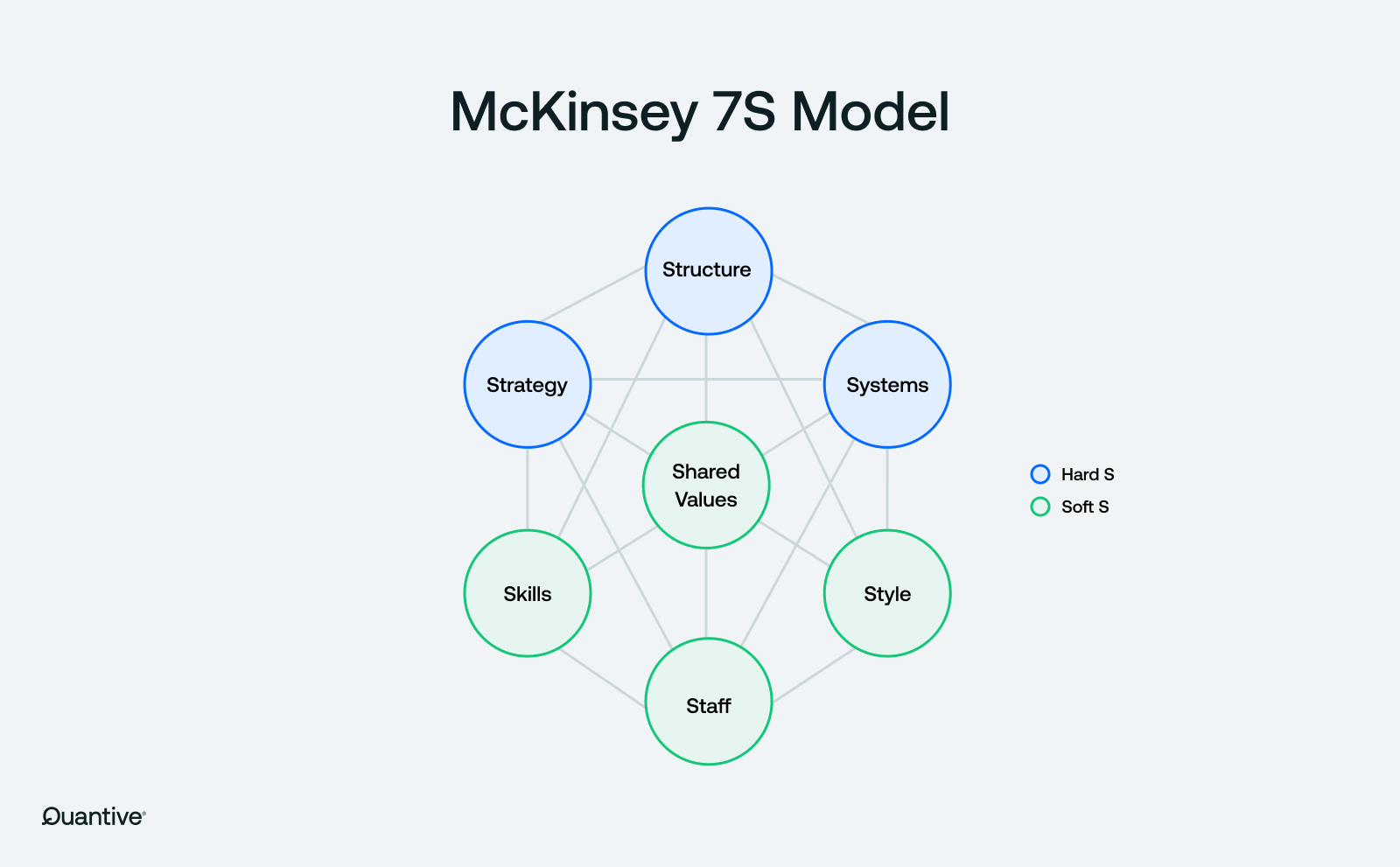Quantive is now part of WorkBoard. Get to know WorkBoard:
Planning the right strategy can be challenging without a structured approach that accounts for all necessary business components. The McKinsey 7S Model provides a strategic framework to help businesses assess how well their internal elements align with their overall strategy.
This article covers the model’s:
- Definition
- Elements
- Origins
- Use cases
- Example
- Steps
- Benefits
What is the McKinsey 7S model?
The McKinsey 7S Model is a strategic framework that helps businesses evaluate and enhance organizational alignment and organizational effectiveness. It assesses how effectively a company's internal 7 key elements — Strategy, Structure, Systems, Shared Values, Skills, Style, and Staff — support its overall strategy, ensuring all components work together harmoniously to achieve business objectives.
Core elements of the McKinsey 7S Model
The 7S Model comprises seven critical elements divided into two categories: Hard S's and Soft S's.

Hard S's
The hard elements include:
- Strategy: The plan devised to maintain and build competitive advantage
- Structure: The way the organization is structured and who reports to whom
- Systems: The daily activities and procedures that staff use to get the job done
Soft S's
The soft elements include:
- Shared values: The core values of the company that are evidenced in the corporate culture and general work ethic
- Skills: The capabilities and competencies that exist within the company
- Style: The leadership style of top management and the company's overall operating approach
- Staff: The employees and their general capabilities
Who developed the McKinsey 7S Model?
Tom Peters and Robert Waterman developed the model at McKinsey & Company in the 1970s. It emphasizes the importance of internal alignment for successful strategy execution.
When to use the McKinsey 7S model?
Here’s when you can choose to rely on the McKinsey 7S model:
- Implementing a new strategy: Ensure all internal elements are aligned to support your new strategic direction
- Improving organizational performance: Identify and address areas of misalignment that may be hindering your business goals and create optimal organizational design
- Mergers and Acquisitions (M&A): Assess compatibility between your company and a potential acquisition target to ensure a smoother integration process
- Organizational restructuring: Gain a comprehensive view of how changes in one area may impact other elements, helping you make more informed decisions
- Cultural transformation: Align shared values, skills, and styles to support the desired cultural shift during times of cultural change
McKinsey 7s Model example: StackAdapt acquires a CDP
Imagine StackAdapt, a company offering a market-leading demand-side platform (DSP), considering acquiring Tealium, a customer data platform (CDP).
The McKinsey 7S Model can help assess alignment for a successful integration:
- Strategy: Does acquiring a CDP align with StackAdapt's strategy of offering a comprehensive solution to advertisers and ad agencies?
- Structure: Will StackAdapt need to adjust its organizational structure to integrate Tealium's operations?
- Systems: Are StackAdapt's existing systems compatible with Tealium's CDP technology?
- Shared values: Do both companies share a customer-centric approach and commitment to data privacy?
- Skills: Does StackAdapt have the necessary skills and expertise to manage and utilize the CDP effectively?
- Style: Is StackAdapt's decision-making style compatible with Tealium's culture?
- Staff: Will there be any redundancies or cultural clashes after the acquisition?
How to use the McKinsey 7S model?
Here’s a step-by-step guide to help you use the McKinsey 7S Model effectively:
Step 1: Define your company's strategy
Establish your organization's overall direction and goals. This strategy will be the foundation for assessing alignment among the seven elements and mastering change management.
Step 2: Analyze each of the 7S elements
Evaluate each element — Strategy, Structure, Systems, Shared Values, Skills, Style, and Staff — and determine how they support or hinder your strategy.
- Strategy: Assess the current strategic plan and its alignment with your business goals
- Structure: Review the organizational structure to ensure it supports efficient decision-making and workflow
- Systems: Examine the processes and procedures in place, ensuring they facilitate the strategy
- Shared values: Identify the core values and culture that drive behavior and decisions within the organization
- Skills: Evaluate the competencies and capabilities of the workforce
- Style: Analyze the leadership approach and management styles
- Staff: Review the human resources, including talent management and development programs
Step 3: Identify areas of misalignment
Look for discrepancies between the elements that may affect strategy execution. Identifying these misalignments is crucial for understanding where changes are needed. Consider conducting surveys, interviews, and workshops to gather insights from different parts of the organization.
Step 4: Prioritize issues
Not all misalignments will have the same impact. Prioritize the areas that need the most urgent attention and those that will have the greatest effect on achieving strategic objectives.
Step 5: Develop action plans
Create specific plans to address identified misalignments. These plans should improve overall effectiveness by ensuring all elements work harmoniously to support your strategy. Your action plans might include:
- Strategy: Refining the strategic plan to ensure clarity and focus
- Structure: Reorganizing teams or departments for better alignment with strategic goals
- Systems: Implementing new processes or upgrading existing ones for better efficiency
- Shared values: Initiating cultural change programs to align values with strategic objectives
- Skills: Developing training and development programs to enhance workforce capabilities
- Style: Adjusting leadership development programs to cultivate the desired management style
- Staff: Enhancing recruitment and retention strategies to build a more aligned workforce
Step 6: Implement the action plans
Execute the developed plans with clear timelines, responsibilities, and resources allocated. Ensure ongoing communication and support from leadership to drive the changes.
Drive alignment using McKinsey 7S and Quantive StrategyAI
Quantive StrategyAI can help you reach your desired goals faster and with confidence. Whether you're using the McKinsey 7S model, the The Ansoff Matrix, or some other strategic planning model, we can help you reach your goals faster.
By offering data-driven insights and scenario planning, Quantive StrategyAI can help you:
- Identify potential gaps between your strategic idea and the market and internal capabilities
- Develop action plans to bridge identified gaps and achieve optimal alignment
- Structure your strategic analysis process to assess potential risks and opportunities
With Quantive StrategyAI as your advisor, you can make faster decisions about momentous business changes such as acquisitions. Thus, ensuring a good integration process ultimately increases your value and performance.





